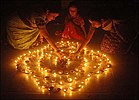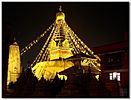HAPPY DIWALI SALE
Diwali or
Deepavali is the
Hindu festival of lights celebrated every year in autumn in the northern hemisphere (spring in southern hemisphere).
[3][4] It is an official holiday in
Fiji,
Guyana,
India,
[5] Malaysia,
Mauritius,
Myanmar,
Nepal,
Singapore,
Sri Lanka,
Suriname,
Trinidad and Tobago, and recently
Sindh Province in Pakistan. One of the most popular festivals of Hinduism, it spiritually signifies the victory of light over darkness, good over evil, knowledge over ignorance, and hope over despair.
[6][7][8] Its celebration includes millions of lights shining on housetops, outside doors and windows, around temples and other buildings in the communities and countries where it is observed.
[9] The festival preparations and rituals typically extend over a five-day period, but the main festival night of Diwali coincides with the darkest, new moon night of the
Hindu Lunisolar month
Kartika in
Bikram Sambat calendar (the month of Aippasi in
Tamil Calendar). In the
Gregorian calendar, Diwali night falls between mid-October and mid-November.
Before Diwali night, people clean, renovate, and decorate their homes and offices.
[10] On Diwali night, people dress up in new clothes or their best outfit, light up
diyas (lamps and candles) inside and outside their home, participate in family
puja (prayers) typically to
Lakshmi – the goddess of fertility and prosperity. After
puja, fireworks follow,
[11] then a family feast including
mithai (
sweets), and an exchange of gifts between family members and close friends. Deepavali also marks a major shopping period in nations where it is celebrated.
[12]
The name of festive days as well as the rituals of Diwali vary significantly among Hindus, based on the region of India. In many parts of India,
[13] the festivities start with
Dhanteras (in Northern and Western part of India), followed by
Naraka Chaturdasi on second day, Deepavali on the third day,
Diwali Padva dedicated to wife–husband relationship on the fourth day, and festivities end with
Bhai Dooj dedicated to sister–brother bond on the fifth day.
Dhanteras usually falls eighteen days after
Dussehra.
Etymology
Diwali celebrations
|
|
Outdoor Diya decoration on Diwali night
|
|
|
|
Diwali and Bandi Chhor Divas celebrations in Amritsar |
Diwali night fireworks over a city ( Chennai) |
|
|
Diwali lamps
|
Diwali festivities include a celebration of sights, sounds, arts and flavors. The festivities vary between different regions. [9][19][20] |
Diwali (
English: )
[3] or
Sanskrit dīpāvali means "series of lights",
[21] and is derived from
dīpam "light, lamp" and
oli "glow of light". Diwali is also known as
dīpotsavam "festival of lights".
The holiday is known as
dipawoli in
Assamese:
দীপাৱলী,
dipaboli or
dipali in
Bengali:
দীপাবলি/দীপালি,
divāḷi in
Gujarati:
દિવાળી,
divālī in
Hindi:
दिवाली,
dīpavaḷi in
Kannada:
ದೀಪಾವಳಿ,
Konkani:
दिवाळी,
Malayalam:
ദീപാവലി,
Marathi:
दिवाळी,
dipābali in
Odia:
ଦିପାବଳୀ,
dīvālī in
Punjabi:
ਦੀਵਾਲੀ,
diyārī in
Sindhi:
दियारी, 'tīpāvaḷi
in Tamil: தீபாவளி, and Telugu: దీపావళి, Galungan in Balinese and Swanti in Nepali: स्वन्ति or tihar in Nepali: तिहार.
History
Diwali dates back to ancient times in India, as a festival after the summer harvest in the Hindu calendar month of
Kartika. The festival is mentioned in Sanskrit texts such as the
Padma Purana, the
Skanda Purana both completed in second half of 1st millennium AD but believed to have been expanded from a core text from an earlier era. The
diyas (lamps) are mentioned in Skanda Purana to symbolically represent parts of the sun, the cosmic giver of light and energy to all life, who seasonally transitions in the Hindu calendar month of Kartik.
[19][22]
Hindus in some regions of India associate Diwali with the legend of Yama and
Nachiketa on Kartika
amavasya (Diwali




























 . Fountainhead of ShoutMeLoud (Award winning blog), speaker at various international forums. Life motto: Live while you can! Teach & inspire while you could & Smile while you have the teeth.
. Fountainhead of ShoutMeLoud (Award winning blog), speaker at various international forums. Life motto: Live while you can! Teach & inspire while you could & Smile while you have the teeth.

Nope…They don’t!
Any thoughts on whether their Boost plan is worth the SEO benefits over their Pro plan?
I”m off to also check out Graphical Tube and the YT viral growth plugin.
Your audience may also appreciate an updated post comparing your vidIQ experience this past year.
~Keri
I Have platinum global card but i am nothing doing for buying this software can u please help me to purchase this software…….
I would recommend Tubebuddy over VidIQ. Cheaper with more features. You can pay via PayPal
Thanks a lot for the information and post. I am going to give it a immediate try now.